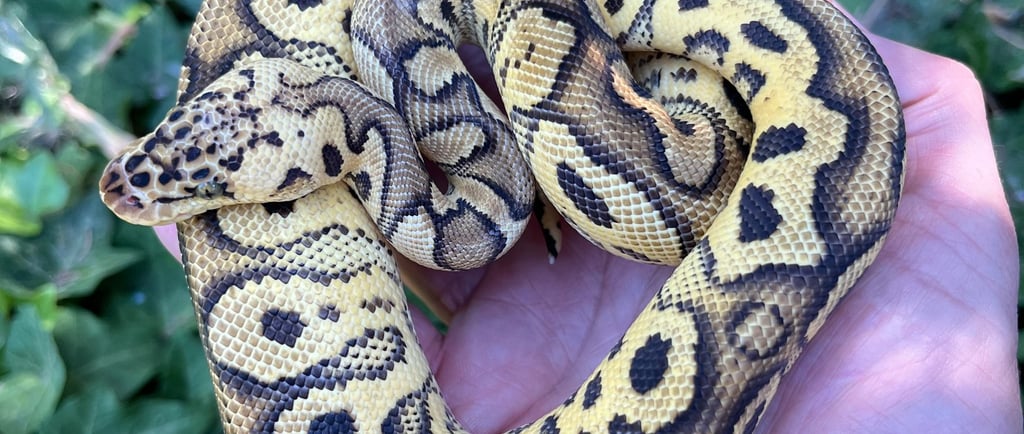Understanding Ball Pythons Genetics: Recessive, Visual, Dominant, and Co-Dominant Genes Explained
If you're stepping into the world of Ball Python breeding, you've probably heard terms like recessive, visual, dominant, and co-dominant thrown around. These aren't just science class flashbacks — they're essential to understand if you want to breed Ball Pythons successfully and ethically. At Emerald City Reptiles, we believe knowledge is power, especially when it comes to working with living animals. So let's break it down in a simple, no-jargon way.
Emerald City Reptiles
7/31/20253 min read


Understanding Ball Python Genetics: Recessive, Visual, Dominant, and Co-Dominant Genes Explained
By Emerald City Reptiles
If you're stepping into the world of Ball Python breeding, you've probably heard terms like recessive, visual, dominant, and co-dominant thrown around. These aren't just science class flashbacks — they're essential to understand if you want to breed Ball Pythons successfully and ethically. At Emerald City Reptiles, we believe knowledge is power, especially when it comes to working with living animals. So let's break it down in a simple, no-jargon way.
🧬 What Do These Genetics Terms Mean?
Let's start by defining what each of these terms means in the Ball Python world.
Recessive Genes
A recessive gene is a type of trait that must be inherited from both parents to visually appear in the offspring.
If a snake has one copy of the gene, it's called a het (short for heterozygous), and it will not show the trait visually.
If it has two copies, it's a visual and you'll see the full expression of that gene.
Examples of Recessive Genes:
Albino
Clown
Pied
Lavender Albino
Ultramel
Why it matters: When you breed two hets together (for the same recessive gene), you have a 25% chance of producing a visual. This potential for success is what makes understanding what's hiding in your snakes genetically crucial. It can be the difference between average and extraordinary outcomes, and it's this potential that keeps breeders motivated and excited about their projects.
Visual
When we say a Ball Python is visual, we mean it is showing the genetic trait, whether that trait is recessive, dominant, or co-dominant.
For example:
A Visual Pied shows the pied pattern.
A Visual Albino is lacking black pigment.
A Visual Banana (co-dom) has bright yellow and lavender colors.
This term is helpful because it tells you what you can see — but not always what's hidden. A visual can also carry additional hidden genes, so it's important to understand lineage and pairings.
Dominant Genes
Dominant traits only need one copy of the gene to show visually. There's no such thing as a "super" form of a dominant gene because having two copies looks exactly the same as having one.
Examples of Dominant Genes:
Spider
Pinstripe
Woma (often considered dominant but debated)
Why it matters: You can't produce a hidden or "het" version of a dominant gene. What you see is what you get — and pass on.
Co-Dominant Genes (a.k.a. Incomplete Dominant)
Co-dominant (often shortened to co-dom) means the gene does show with one copy, but if the snake has two copies, the trait is exaggerated or enhanced — we call this a 'super form,' which is a term used to describe the enhanced expression of a co-dominant gene when two copies are present.
Examples of Co-Dominant Genes:
Banana / Super Banana
Pastel / Super Pastel
Mojave / Super Mojave
Lesser / Super Lesser
Why it matters: Breeding co-dom to co-dom gives you a shot at producing supers, which can look wildly different — sometimes with more intense color or pattern changes. Supers are also useful because they always pass down at least one copy of the gene to their offspring.
🎯 Why Understanding This Matters for Breeding
If you're pairing snakes without knowing how these genetics work, you're basically gambling — and the stakes are living animals.
Here's why you should understand what you're working with:
Predicting Offspring: You'll have a clear idea of what genes you might produce, which helps with planning, pricing, and future projects.
Avoiding Surprises: You don't want to breed two hets for different recessives and end up confused when odd-looking babies hatch.
Selective Breeding: You can plan your projects to refine or intensify traits, creating stunning animals with higher value and unique appeal.
Responsibility: Knowing genetics helps prevent health issues, like combining genes that are known to cause problems (e.g., Spider x Spider = neurological issues).
🐍 Final Thoughts
Ball Python genetics can seem intimidating at first, but once you understand the differences between recessive, visual, dominant, and co-dominant genes, it becomes a powerful tool. At Emerald City Reptiles, we've built our breeding programs on a foundation of genetic understanding and ethical pairings.
Whether you're dreaming of producing your first Clown Pied or just trying to make sense of your Banana het Albino female — knowledge is your best investment.
Happy herping, which is a term used in the reptile community to describe the act of searching for reptiles in their natural habitat, and as always, feel free to reach out if you have questions about your breeding plans or need help identifying a morph!
#BallPythonGenetics #ReptileBreeding #EmeraldCityReptiles #BallPythons #KnowYourMorphs #SnakeBreedingBasics
Blog / Ball Pythons
Explore our insights on ball python breeding.
CONTACT
Sign Up for Updates no spam
info@ecreptiles.com
© 2025. Emerald City Reptiles All rights reserved.


